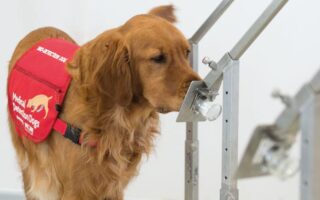Unleashing Potential: The Legacy of Barbara Woodhouse, Dog Trainer Extraordinaire
In the realm of canine companionship, few figures have made as profound an impact as Barbara Woodhouse. Renowned for her innovative training techniques and her unwavering belief in the bond between humans and their four-legged friends, Woodhouse became a household name in the world of dog training. With a charming presence and a unique approach that blended discipline with affection, she demystified the art of training dogs and transformed the way we understand their behavior. This article explores the life, methods, and enduring legacy of Barbara Woodhouse, a pioneer who not only trained dogs but also captivated the hearts of countless pet owners around the globe. Join us as we delve into her journey, the principles that guided her work, and the lasting influence she has left on trainers and dog lovers alike.
Table of Contents
- The Legacy of Barbara Woodhouse: Revolutionizing Dog Training Techniques
- Understanding Canine Behavior: Insights from Woodhouses Approach
- Essential Training Tools: What Every Dog Owner Should Have
- Practical Tips for Transforming Your Dog: Recommendations Inspired by Woodhouse
- Q&A
- In Retrospect
The Legacy of Barbara Woodhouse: Revolutionizing Dog Training Techniques
Barbara Woodhouse’s impact on dog training extends far beyond her innovative techniques. She is perhaps best known for her engaging television personality and her ability to communicate complex training methods in a way that was accessible to dog owners everywhere. Woodhouse popularized the concept of positive reinforcement, moving away from the punitive methods of her time. Her unique approach emphasized the importance of understanding canine behavior, which encouraged pet owners to build a bond with their dogs based on mutual respect and trust. Key aspects of her training philosophy include:
- Consistency: Ensuring that commands and expectations are clear and uniform.
- Patience: Allowing dogs time to learn and adapt to new commands and behaviors.
- Affection: Using praise and rewards to reinforce good behavior.
Woodhouse’s techniques were not just effective; they were transformative. She believed that a happy dog was a well-trained dog, which led her to advocate for training methods that nurtured a loving relationship between pets and their owners. Her book, “Training Your Dog,” along with her television series, made her an iconic figure in the realm of dog training. Barbara’s legacy is not just in the methods she developed but also in the community she built around dog ownership, where understanding and compassion reign supreme. This can be reflected in her impactful teaching points, summarized in the table below:
| Training Principle | Benefit |
|---|---|
| Positive Reinforcement | Encourages desired behaviors with rewards. |
| Socialization | Prepares dogs for diverse environments and experiences. |
| Playfulness | Creates a fun atmosphere that promotes learning. |
Understanding Canine Behavior: Insights from Woodhouses Approach
Barbara Woodhouse’s methodology reshaped the understanding of canine behavior, emphasizing the importance of communication between dogs and their owners. Central to her approach is the belief that a dog’s actions often reflect their emotional state and environmental influences. By observing the subtle cues in a dog’s body language, owners can gain invaluable insights into their pet’s feelings and intentions. Woodhouse advocated for the use of positive reinforcement to encourage desirable behavior, demonstrating that it builds trust and strengthens the bond between the dog and its handler.
To break down some of the key concepts from her training philosophy, consider the following principles:
- Consistency: Always apply the same rules to help dogs understand expectations.
- Patience: Progress may be slow, but persistence yields results.
- Socialization: Expose dogs to various environments and experiences for well-rounded behavior.
- Training sessions: Short, frequent sessions are more effective than longer, infrequent ones.
In each training session, it’s crucial to focus on the overall emotional well-being of the dog, ensuring they feel safe and engaged. Below is a simple table summarizing the reward methods Woodhouse endorsed:
| Reward Method | Description |
|---|---|
| Verbal Praise | Encouragement through a happy tone reinforces positive behavior. |
| Treats | Food rewards are effective but should be used strategically. |
| Playtime | Engaging in fun activities strengthens the owner-dog relationship. |
Essential Training Tools: What Every Dog Owner Should Have
Every dog owner embarking on a training journey should be equipped with a set of essential tools that foster effective communication and promote positive interactions between them and their furry companions. A collar and leash are fundamental for controlling your dog during walks and ensuring safety in various environments. Complementing these are training treats, small morsels that serve as rewards for good behavior, making training sessions enjoyable and motivating for your pup. Other crucial tools include a clicker for marking desired behaviors immediately, and a training crate that aids in house training while providing a secure space for your dog.
To further enhance your training experience, consider adding a few more resources to your toolkit. A puppy training pad can be beneficial for indoor training, especially for young puppies still learning to manage their bladder. Additionally, an assortment of chew toys can keep your dog occupied and discourage destructive habits. To track progress, maintaining a training journal can help you note important observations, breakthroughs, and areas needing improvement. Each of these tools plays a unique role in shaping your dog’s behavior and strengthening your bond with them.
Practical Tips for Transforming Your Dog: Recommendations Inspired by Woodhouse
Transforming your dog into a well-mannered companion can be achieved through patience, consistency, and a sprinkle of creativity inspired by Barbara Woodhouse. Start by establishing a routine, as dogs thrive on structure. Schedule regular training sessions, walks, and playtime to foster a sense of security. Utilize rewards-based training methods, such as treats or praise, to encourage positive behaviors. A few practical strategies include:
- Short Training Sessions: Keep sessions brief (5-10 minutes) to maintain your dog’s attention.
- Consistent Commands: Use the same verbal cues and hand signals to avoid confusion.
- Socialization: Expose your dog to various environments, people, and other pets to build confidence.
Incorporating play into training can also enhance the bond between you and your dog. Games such as fetch or hide-and-seek not only provide physical exercise but also encourage mental stimulation. Furthermore, consider the establishment of a simple record-keeping system to track your dog’s progress. A table can help visualize this development:
| Skill | Status | Notes |
|---|---|---|
| Sit | Achieved | Responds quickly to command. |
| Stay | In Progress | Needs reinforcement with longer durations. |
| Recall | Achieved | Comes when called from a distance. |
Q&A
Q&A: Discovering the Legacy of Barbara Woodhouse, Renowned Dog Trainer
Q: Who was Barbara Woodhouse?
A: Barbara Woodhouse was a pioneering dog trainer and author from the United Kingdom, best known for her innovative training techniques and her ability to connect with dogs and their owners. Born in 1910, she gained fame in the 1970s and 1980s with her television shows and books, making her one of the most influential figures in the world of dog training.
Q: What made Barbara Woodhouse’s training methods stand out?
A: Woodhouse’s methods were notable for their emphasis on communication and understanding between the dog and its owner. She advocated for positive reinforcement and a firm, yet gentle approach, often incorporating simple commands and consistency in training. Her famous phrase, “Walkies!” became synonymous with her approachable and engaging style.
Q: What types of training techniques did she introduce?
A: Among her techniques, Woodhouse introduced the idea of teaching dogs with kindness and respect, promoting a bond based on trust. She combined vocal commands with hand signals and demonstrated how to correct unwanted behavior without resorting to harsh methods. Her approach emphasized the importance of patience and perseverance in training sessions.
Q: How did Barbara Woodhouse influence dog training culture?
A: Woodhouse played a vital role in changing public perception of dog training. By presenting it as an enjoyable and rewarding experience rather than a chore, she inspired many to adopt dogs and engage in training. Her work has influenced generations of dog trainers, fostered a more humane approach to behavior modification, and contributed to what is now known as positive reinforcement training.
Q: What impact did her books have on dog owners?
A: Woodhouse authored several popular books on dog training, including “No Bad Dogs,” which became a bestseller and is still referenced today. Her books not only provided practical advice but also instilled confidence in dog owners, encouraging them to take an active role in their pet’s upbringing. With her straightforward language and engaging anecdotes, she made dog training accessible to all.
Q: What is Barbara Woodhouse’s legacy today?
A: Barbara Woodhouse’s legacy endures through her books, television appearances, and the countless trainers and pet owners she has inspired. Her mantra of partnership between dog and owner continues to resonate in contemporary training philosophies, reminding us that a strong bond leads to happier, well-adjusted pets. Today, many trainers honor her methods by emphasizing empathy and understanding in their practice—essential themes of her teachings.
Q: How can dog owners learn more about her methods?
A: For those interested in learning more about Barbara Woodhouse’s methods, her books are readily available in print and digital formats. Additionally, many online resources—including video tutorials and training workshops—draw on her principles, ensuring her influence remains alive in the world of canine companions. Dog owners can also explore local training classes that emphasize positive reinforcement and the kind of gentle leadership Woodhouse advocated.
In Retrospect
As we reflect on the enduring legacy of Barbara Woodhouse, the pioneering dog trainer whose influence shaped the way we interact with our canine companions, it becomes clear that her approach transcended mere obedience. Through her innovative methods and unparalleled compassion, she taught us that training is not just about commands, but about understanding and building a bond with our pets. Her work remains a guiding light for dog enthusiasts and trainers alike, reminding us that patience, consistency, and love are the foundations of a harmonious relationship with our four-legged friends. Whether you are a seasoned trainer or a pet owner just embarking on this journey, Barbara Woodhouse’s principles continue to inspire and resonate, encouraging us all to connect more deeply with the animals that share our lives. As we close this exploration of her remarkable contributions, let us carry forward her timeless wisdom, fostering mutual respect and joy in the human-animal bond.



